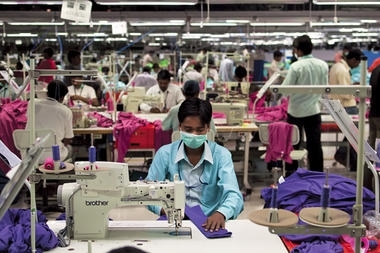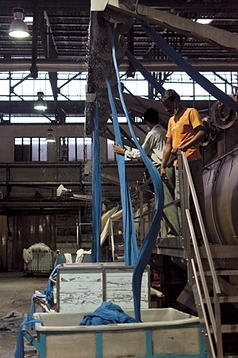 |
| A man works at a sewing machine in the Pratibha Syntex garment factory. |
If you want to be "green," you may have to change your clothes. And your sheets.
The environmental impact of the global textile industry is hard to overstate. One-third of the water used worldwide is spent fashioning fabrics. For every ton of cloth produced, 200 tons of water is polluted with chemicals and heavy metals. An estimated 1 trillion kilowatt-hours of electricity powers the factories that card and comb, spin and weave, and cut and stitch materials into everything from T-shirts to towels, leaving behind mountains of solid waste and a massive carbon footprint.
"Where the industry is today is not really sustainable for the long term," says Shreyaskar Chaudhary, chief executive of Pratibha Syntex, a textile manufacturer based outside Indore, India. The company, which specializes in ready-to-wear clothing, makes garments for Nike, Hanes, Wal-Mart, and Ralph Lauren.
With something of an "if you build it, they will come" attitude, Mr. Chaudhary has steered Pratibha toward the leading edge of eco-friendly textile production.
Under his direction, Pratibha began making clothes with organic cotton in 1999. Initially, the company couldn't find enough organic farms growing cotton in central India to supply its factories.
To meet production demands, Chaudhary's team had to convince conventional cotton farmers to change their growing methods. Pratibha provided seeds, cultivation instruction, and a guarantee of fair-trade prices for their crops. Today, Pratibha has a network of 28,000 organic cotton growers across the central states of Madhya Pradesh, Maharashtra, and Orissa.
Within the factories themselves, Pratibha has invested some $100 million in sustainable technologies over the past three years.
Thanks to innovative salt-free, low-impact dyes used on all material they produce, 92 percent of their manufacturing waste water can be reclaimed and reused.
 |
| Pratibha Syntex garment factory workers dye cotton using technologies that yield little harmful waste. |
Pratibha meets 90 percent of its water needs by using water recycling and rainwater harvesting technologies.
Still, Chaudhary estimates that, at this point, only a quarter of the garments Pratibha makes qualify as "sustainable" and he wants to improve upon that.
Why the urgency? Growing natural fibers is a huge drain on resources. Cotton fields soak up 25 percent of all insecticides sprayed on the planet and require some 2,600 gallons of water for every pound of white fluff grown. The Aral Sea, once the world's fourth-largest lake, is now 15 percent of its original size – a victim of large-scale cotton irrigation projects. But synthetic material isn't any better, since its production is toxic and its fibers take decades to biodegrade.
To alleviate this heavy strain, Chaudhary brought in giant machines capable of recycling solid textile waste, turning the discarded material into usable fabrics.
The solid waste typically comes in two forms: cotton lint lost along the way during various production processes (soft waste) and scrap material left over after garments are finished (hard waste).
Soft waste is collected; the cotton fibers are opened, cleaned, and baled before heading for the production line. Hard waste must be gathered, color-stripped, shredded, and crushed so intensely that it's broken down to resemble raw fiber.
Since recycled fibers are shorter than virgin fibers, they produce fabric that is slightly heavier and coarser. As a result, they're often blended with virgin fibers for improved texture and integrity, yielding material with unique qualities.
The head of Pratibha's nascent design and innovation department is Karina Michel, an American with a degree in fashion design from the California College of the Arts in San Francisco.
She recognizes that "recycled fabrics are not premium fabrics in terms of fiber length," but points out that they are perfect for plenty of style choices, including the slightly heavier materials often used in autumn fashion collections.
She says a big part of her job is turning waste into quality, recycled textiles that people want to wear: "I would rather someone purchase something I've designed because it looks great and happens to be made from recycled fiber than buy it just because it's made from recycled fiber."
Because Pratibha relies on retailers to deliver its environmentally sound products to consumers, the company has developed its sustainable technologies carefully with an emphasis on collaboration and marketing.
"We have the manufacturing expertise; they have the retail expertise. So it makes sense to collaborate when designing this new kind of product," says Aditya Goyal, Pratibha's executive director.
Pratibha partners with a number of clothing companies, including Tesco and Marks & Spencer – both important names in the British fashion industry – on its sustainable textile crusade.
Once the recycled-fabric lines are ready to hit store shelves, Mr. Goyal imagines they'll take off.
"Our customers really do care about clean manufacturing, and so do their customers," he says.
Pratibha plans to brand its recycled fabric under the name LOOP. The clothes may come with special tags that carry from one retailer to another – "the way Gore-Tex is branded," Goyal says, "so shoppers know at a glance that it's eco-friendly."
While there are other textile companies out there looking to move in an eco-friendly direction, they generally do so only when their clients insist upon it, says fashion designer Lynda Grose, coauthor of the book "Sustainable textiles: Life cycle and environmental impact" and a sustainability consultant to retailers such as The Gap, Banana Republic, and Old Navy.
Pratibha, on the other hand, is "identifying and acting on its own initiatives and then offering these as an added value to their brand clients," says Ms. Grose.
Many clothing brands, she says, do want to "green" their lines, either because they sense a trend and don't want to be left behind or because they know that the natural resources upon which their businesses depend are being depleted.
"The prevailing business model," Grose says, "which is dependent on producing high volumes of merchandise and pushing it through to retail each season, is inherently unsustainable."
What the industry needs, she says, is a major make-over – from the farms to the factories. "Pratibha's recycled line is an example of this type of change," Grose says.
Ms. Michel says that her entire perspective on waste has shifted since working in Pratibha's design and innovation department.
"What we define as textile waste can easily be defined as raw materials," she says.
And Pratibha is embracing that view. "In less than one year of implementing our recycling program, LOOP, we've reduced our spinning and garment-cut waste by more than half, and plan to reach zero-waste manufacturing within two years," Michel says.
"It's very exciting. I look forward to the day when we say 'We've run out of waste! Where can we get more waste?' "
Page created on 3/26/2011 12:00:00 AM
Last edited 1/5/2017 9:56:20 PM
